苏教版牛津英语初中八年级上册精品优秀教案全册
八年级英语上册全册教案(牛津版)
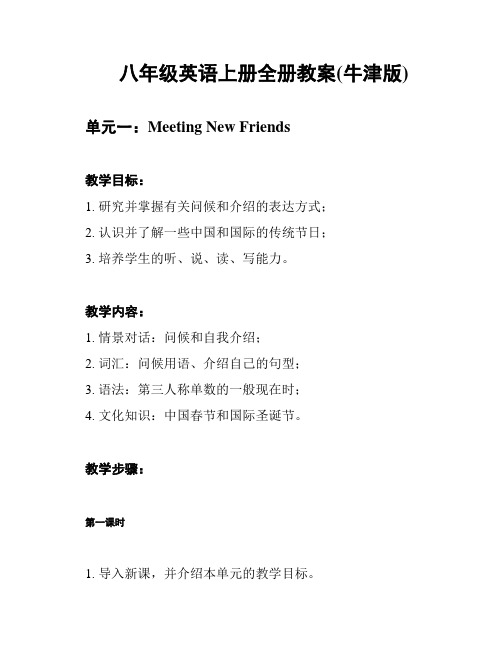
八年级英语上册全册教案(牛津版)单元一:Meeting New Friends教学目标:1. 研究并掌握有关问候和介绍的表达方式;2. 认识并了解一些中国和国际的传统节日;3. 培养学生的听、说、读、写能力。
教学内容:1. 情景对话:问候和自我介绍;2. 词汇:问候用语、介绍自己的句型;3. 语法:第三人称单数的一般现在时;4. 文化知识:中国春节和国际圣诞节。
教学步骤:第一课时1. 导入新课,并介绍本单元的教学目标。
2. 向学生介绍中外节日,并讨论他们对节日的认识。
3. 研究常用的问候语,例如:Hello, Hi, How are you, Fine, thank you. And you?等等。
通过角色扮演对话,练问候和回答。
4. 研究自我介绍的句型,例如:My name is Lucy. I'm twelve years old. I'm from China,等等。
学生之间进行自我介绍的练。
第二课时1. 复上节课学过的问候语和自我介绍的句型。
2. 研究第三人称单数的一般现在时。
向学生介绍第三人称单数的规则,并进行一些练。
3. 引入中国春节和国际圣诞节的文化知识,向学生介绍春节和圣诞节的起源、传统俗和庆祝方式。
让学生了解不同文化之间的差异。
4. 学生分组讨论,比较中国春节和国际圣诞节的异同。
第三课时1. 复上节课学过的第三人称单数的一般现在时。
2. 研究和巩固本单元的重点词汇和短语,例如:celebrate, tradition, festival,等等。
通过词汇游戏和练,提高学生的词汇水平。
3. 听力训练:播放录音,让学生听一段对话,然后回答问题。
通过听力训练提高学生的听力能力。
4. 朗读训练:让学生分角色朗读课文中的对话,提高学生的口语和阅读能力。
总结:通过本单元的教学,学生将学会基本的问候和自我介绍的英语表达方式,掌握第三人称单数的一般现在时的用法,了解中国春节和国际圣诞节的文化知识,并通过听、说、读、写的训练,提高学生的英语综合能力。
江苏版牛津英语八年级上Unit 7 Seasons 教案
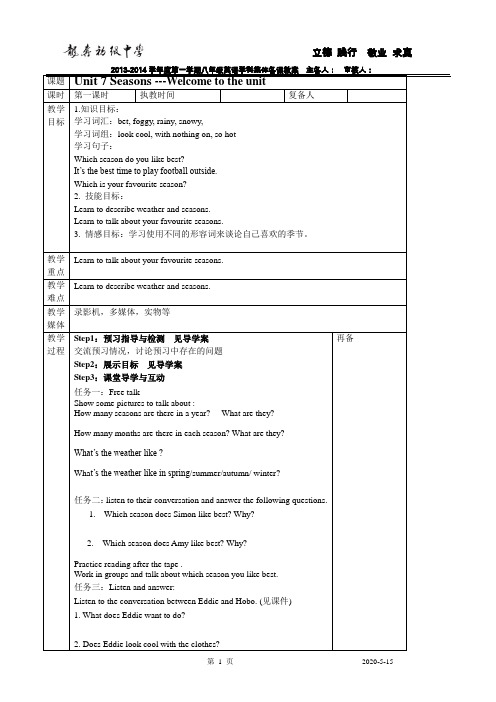
Step1:预习指导与检测见导学案
Step2:展示目标见导学案
Step3:课堂导学与互动
任务一:Free talk
1.Which is the best season?
•Spring is the best season of the year. It’s warm and windy. It’s the best time to fly kites. It’s the best time for trees and flowers to grow. Bees and butterflies play among flowers. If the rain comes, they hide from the April showers.
3.情感目标:学习把对每个季节的感受充分融入到诗歌朗诵中去。
教学重点
1)Understand the poem.
2)Master the new words in this poem.
教学难点
Enrich your vocabulary on the four seasons.
学法指导
查阅资料与练习相结合。
2.Which season does Amy like best? Why?
Practice reading after the tape .
Work in groups and talk about which season you like best.
任务三:Listen and answer:
(3) Why do the birds fly far away?
Spring:
(1)What can we do in spring?
苏教版译林牛津初中英语8AUnit8L7教案
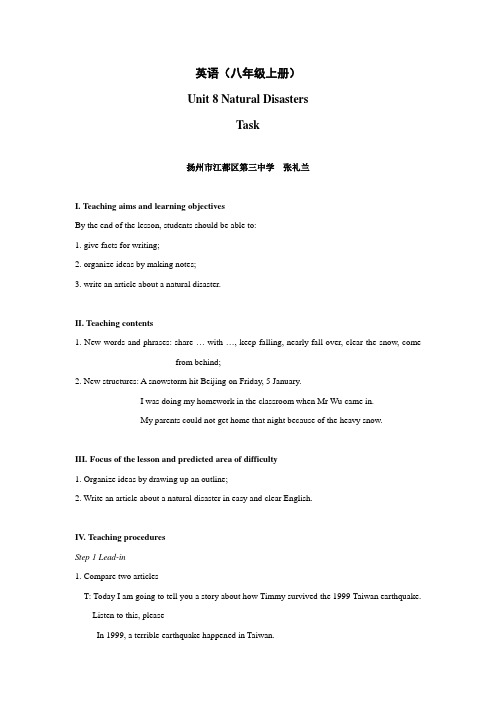
英语(八年级上册)Unit 8 Natural DisastersTask扬州市江都区第三中学张礼兰I. Teaching aims and learning objectivesBy the end of the lesson, students should be able to:1. give facts for writing;2. organize ideas by making notes;3. write an article about a natural disaster.II. Teaching contents1. New words and phrases: share … with …, keep falling, nearly fall over, clear the snow, comefrom behind;2. New structures: A snowstorm hit Beijing on Friday, 5 January.I was doing my homework in the classroom when Mr Wu came in.My parents could not get home that night because of the heavy snow.III.Focus of the lesson and predicted area of difficulty1. Organize ideas by drawing up an outline;2. Write an article about a natural disaster in easy and clear English.IV. Teaching proceduresStep 1 Lead-in1. Compare two articlesT: Today I am going to tell you a story about how Timmy survived the 1999 Taiwan earthquake.Listen to this, pleaseIn 1999, a terrible earthquake happened in Taiwan.At first Timmy was sleeping. When he felt the shaking, he wanted to run out of the building, but he failed. And unluckily he was trapped in the dark. After that, he calmed down and tried to find his way out.At last, some people heard him and saved him.T: What do you think of the story? Do you think I’m good at telling stories? Why or why not?Is there anything good in my story?T: Here are some good points and bad points of my version. So you all think Timmy’s version is better than mine. And I agree with you. Now let’s g o over the structure of Timmy’s version.In Timmy’s version we can see the changes of his feelings, and we can see how terrible the earthquake was. It seems that we were there with him at that time. How do we have such feelings? First, articles in the first person make it easier for readers to have the same feelings as the writer’s. Second, f acts in details help support the writer’s opinion.2. Work out the structureT: Now I think you know how to write a natural disaster. Maybe we can give Timmy’s version a little bit change.e.g.: At last, I was safe. I was so happy to see the bright daylight again.【设计意图:通过比较两则关于Timmy在地震中的故事,让学生了解关于自然灾害的文章的写作结构,并初步认识细节描写的重要性。
苏教版(凤凰)牛津英语教案8AU3reading
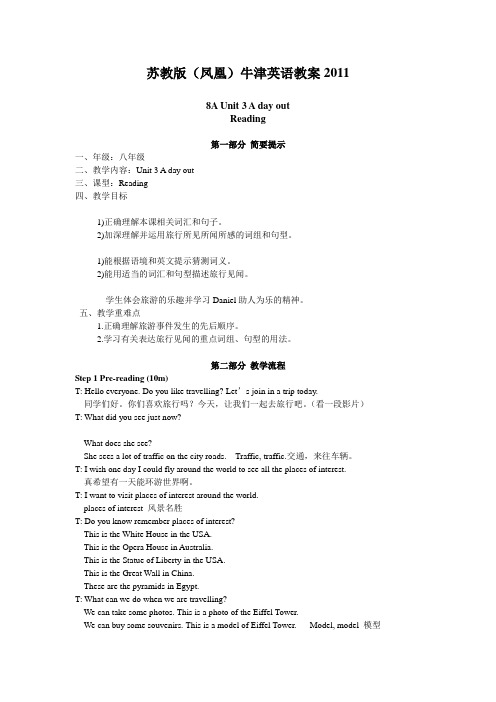
苏教版(凤凰)牛津英语教案20118A Unit 3 A day outReading第一部分简要提示一、年级:八年级二、教学内容:Unit 3 A day out三、课型:Reading四、教学目标1)正确理解本课相关词汇和句子。
2)加深理解并运用旅行所见所闻所感的词组和句型。
1)能根据语境和英文提示猜测词义。
2)能用适当的词汇和句型描述旅行见闻。
学生体会旅游的乐趣并学习Daniel助人为乐的精神。
五、教学重难点1.正确理解旅游事件发生的先后顺序。
2.学习有关表达旅行见闻的重点词组、句型的用法。
第二部分教学流程Step 1 Pre-reading (10m)T: Hello everyone. Do you like travelling? Let’s join in a trip today.同学们好。
你们喜欢旅行吗?今天,让我们一起去旅行吧。
(看一段影片)T: What did you see just now?What does she see?She sees a lot of traffic on the city roads. Traffic, traffic.交通,来往车辆。
T: I wish one day I could fly around the world to see all the places of interest.真希望有一天能环游世界啊。
T: I want to visit places of interest around the world.places of interest 风景名胜T: Do you know remember places of interest?This is the White House in the USA.This is the Opera House in Australia.This is the Statue of Liberty in the USA.This is the Great Wall in China.These are the pyramids in Egypt.T: What can we do when we are travelling?We can take some photos. This is a photo of the Eiffel Tower.We can buy some souvenirs. This is a model of Eiffel Tower. Model, model 模型It is not a real one. This is the real one.The real one is made of metal. It’s a metal tower. Metal, metalThis is a model pyramid.These are real pyramids.T: There are so many places of interest around the world. But we don’t have enough time or money to visit them one by one. What can we do?T: Let me show you a nice place. It is called the World Park in Beijing.It is a big park. There, we can travel around the world in a day!在北京世界公园,我们可以在一天之内环游世界。
苏教版译林牛津初中英语8A教案Unit7L7

英语(八年级上册)Unit 7 SeasonsTask扬州市广陵区霍桥学校聂万攀I. Teaching aims and learning objectivesBy the end of the lesson, students should be able to:1. write an outline about our favourite season;2. write an article about our favourite season.II. Teaching contents1. New words and phrases: deep, frozen, land, exciting, throw, scream, snowman (snowmen), ice,everywhere,be covered in deep white snow, have snowball fights,throw snowballs, at each other, make snowmen, use carrots for theirnoses, ice lanterns;2. New structures: Moreover, I enjoy …It’s exciting to…We throw snowballs at each other, screaming and laughing.It’s often sunny/windy/rainy…III.Focus of the lesson and predicted area of difficultyDeve lop the students’ writing ability.IV. Teaching proceduresStep 1 Lead-inWatch a video about the four seasonsT: Today we’ll learn Unit 7 Task. First watch a video, please.【设计意图:观看视频,激活旧知,提高兴趣,导入新课。
初二牛津英语上册教案
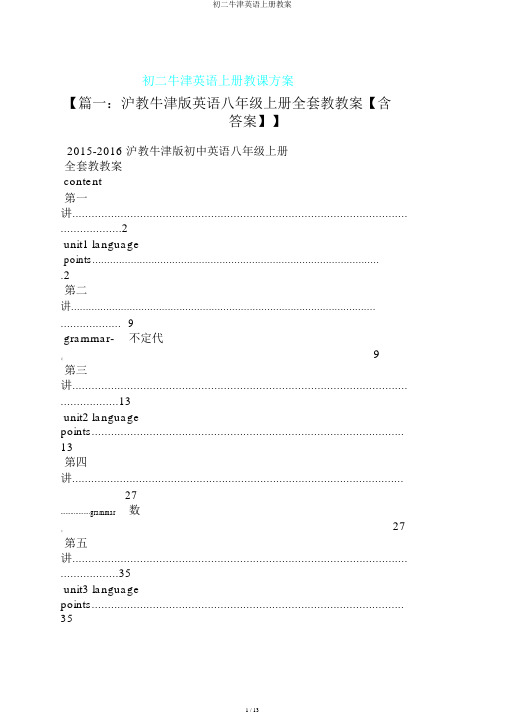
初二牛津英语上册教课方案【篇一:沪教牛津版英语八年级上册全套教教案【含答案】】2015-2016 沪教牛津版初中英语八年级上册全套教教案content第一讲........................................................................................................ . (2)unit1 language points..................................................................................................2第二讲........................................................................................................ . (9)grammar-不定代词 (9)第三讲........................................................................................................ (13)unit2 language points (13)第四讲..........................................................................................................................grammar-27数词 (27)第五讲........................................................................................................ (35)unit3 language points (35)第六讲........................................................................................................ (46)grammar-形容词和副词 (46)第七讲........................................................................................................ (56)unit4 language points.................................................................................................56第八讲..........................................................................................................................grammar-70形容词副词同级比较 (70)第九讲........................................................................................................ (76)unit5 language points (76)第十讲........................................................................................................ (89)grammar- 此刻达成时.......................................................................................89第十一讲........................................................................................................ .. (97)unit6 language points.................................................................................................97 第十二讲........................................................................................................ ............108grammar-此刻达成时补充.............................................................................108第十三讲....................................................................................................................116 unit7 language points.. (1)16 第十四讲........................................................................................................ ............128grammar-if条件状语从128第十五句..............................................................................讲........................................................................................................ ............133 unit8 language points.. (1)33 第十六讲........................................................................................................ ............138grammar-神态动138优乐词.........................................................................................单元测........................................................................................................ .. (144)vocabulary......................................................................................... . (230)1八年级上册英语教课方案资料第一讲unit1◆ 知识研究1. is my encyclopaedia , lo?1) useful:实用的,有利的,有帮助的 a useful book2) use +ful= useful名词+ful=形容词3)以-ful 结尾的形容词的反义词多是相应的以 -less 结尾的形容词。
江苏牛津版初二 8A unit1辅导教案
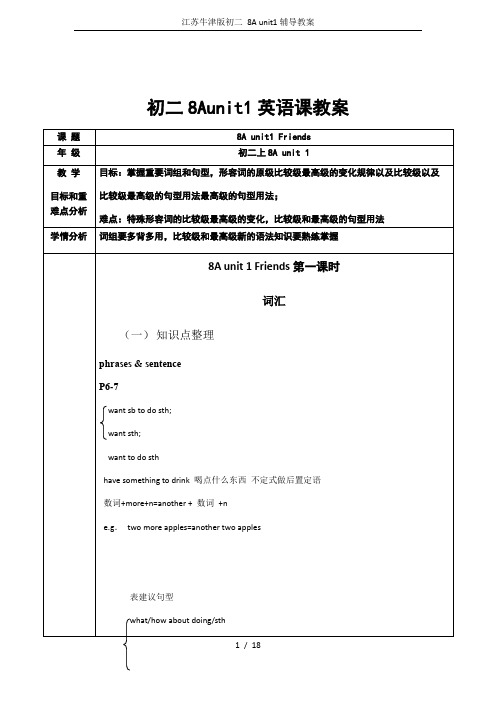
课题
8A unit1Friends
组名
桥北组
教师
蒋露
年 级
初二上8A unit 1
教学
目标和重难点分析
目标:掌握重要词组和句型,形容词的原级比较级最高级的变化规律以及比较级以及
比较级最高级的句型用法最高级的句型用法;
难点:特殊形容词的比较级最高级的变化,比较级和最高级的句型用法
be famous for…以…而出名
listen to sb’problems…倾听某人的问题…
travel around the world环游世界
social worker社会工作者
society. n社会
work of art艺术品pl:works of art
learn more/a lot about sth对…了解更多/很多
look作为n时,一般用pl,looks相当于appearance
square方形的;平方的(square metre);
n.广场Tian’an men~
handsome:一般用于形容男生
fat. adj胖的fatter-fattest n.脂肪
patient:耐心的impatient无耐心的
be ~ with sb/sth对某人/某物耐心patience n.耐心—impatience
二、课堂练习
P6-7
填空
1.I’m t_____. MayIhave something to drink?
2.Do you think a friend should be h_______?
3. It’s a s_______ between you and me. Don’t tell others.
江苏省八年级英语牛津版上《Unit2 School life Welcome to the Unit》设计方案
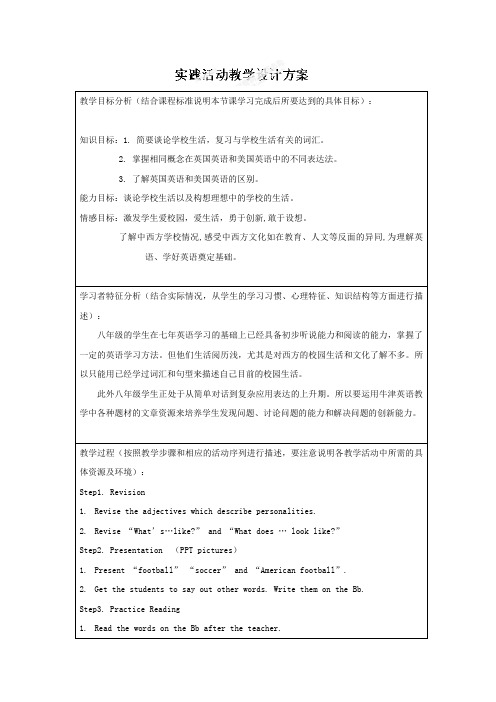
Licence(n.)
Practice(v.)
License(n.)
Step5. Reading (computer, recorder)
1.Listen to the tape, answer one question.
2.Read the dialogue by themselves. Answer some more questions.
Add more examples:
Useful words
British
American
Favourite, colour, harbour
Favorite, color, harbor
Centre, theatre
Center, theater
traveller
traveler
cheque
Check
课堂延伸过程评价
通过学习,学生能凭借查找的资料,利用在课堂上进行热烈的讨论。
对教师的评价
对教材的理解与把握
教师对教材的理解深入浅出,重难点把握准确,教学方法使用恰当。
教师对问题的处理
问题设计恰当、合理,具有较大的启发性和吸引力,能促进学的达成
立足于学生已有的知识基础,遵循学生自身从发现问题到解决问题整个过程中,获取知识的认知规律。通过对话题的认识、讨论过程,潜移默化地达成能力和情感目标。
3.Fill in blanks in Part B, get the Ss to check answers in class. Read the words aloud.
Step4. Practice
Do some exercises about these British English and American English.
- 1、下载文档前请自行甄别文档内容的完整性,平台不提供额外的编辑、内容补充、找答案等附加服务。
- 2、"仅部分预览"的文档,不可在线预览部分如存在完整性等问题,可反馈申请退款(可完整预览的文档不适用该条件!)。
- 3、如文档侵犯您的权益,请联系客服反馈,我们会尽快为您处理(人工客服工作时间:9:00-18:30)。
苏教版牛津英语初中八年级上册精品优秀教案全册————————————————————————————————作者:————————————————————————————————日期:苏教版牛津英语初中八年级上册精品教案全册《牛津初中英语》8AUnit 1 Friends Checkout简要提示一、年级:八年级二、教学内容:8A Unit 1 Friends三、课型:Checkout四、教学目标1.知识目标1) 掌握与本单元描述人物特征话题有关的词汇及句型。
2) 掌握并能熟练运用形容词的比较级和最高级。
2.能力目标1) 能知道如何描述人的外貌。
2) 能用形容词来描述人物或事物。
3) 能掌握形容词的比较级和最高级。
五、教学重难点采用多种方法巩固、加深理解并熟练运用与本单元话题有关的语言点和语法。
教学流程Part One Language points revision (用时:18分钟)Step 1 Revision (用时:5分钟)We know this unit is about friends. 我们都知道这一单元的中心话题是关于朋友。
After learning this unit, we should know how to use adjectives to describe our friends’general appearance, personality and abilities.学完这一单元后,我们应该知道如何用形容词来描写我们朋友的外貌、个性和能力。
And we should also learn to introduce our friends. 我们还应该学会介绍我们的朋友。
First, let’s look at these pictures and talk about them.首先,下面让我们来看这些图片并谈论他们。
A is strong.B is thin.A has big eyes.B has small eyes.A is short.B is tall.A has a square face.B has a round face.Step2 Practice (用时:5分钟)OK, now you’ll see three persons in a group. I’ll describe one of them, listen carefully, then try to choose the right one.现在看这些人物,我将会描述他们,仔细听,从三副画中选择我所描述的人。
(可以读两遍) No. 1 He is very tall, almost 1.75meters. He had poor eyesight and wears small, round glasses. No. 2 She is small and pretty. She has straight, shoulder-length hair.No. 3 She is slim and her hair is short.Step3 Presentation (用时:8分钟)Daniel is writing in hi s diary about the articles he read in ‘Teenagers ’ magazine.丹尼尔正在写日记, 内容是关于他在‘青少年’杂志上读的文章。
What’s he writing? Do you want to know?Open your books, turn to page 21, read Part B carefully, then finish it with the correct words from the box. 现在请同学们把书打开翻到21页,仔细阅读B部分,并用合适的词填空。
OK, now let’s check the answers.下面让我们核对答案。
Answers to Part B:1 square2 small3 tidy4 sense of humour5 smartPart Two Grammar revision (用时:15 分钟)Step1 Revision (用时:5分钟)We know we can use adjectives to describe someone or something. We can put an adjective before a noun or after a linking verb.我们可以用形容词来描述人或事。
我们可以把形容词放在名词之前作定语或系动词之后作标语。
There are two sentences, please chang each of them into another way.同学们将看到两句话,请逐一将他们转换为另一种表达法。
1. Kate is tall and slim. Kate is a ____________ girl.2. She has bright and smiling eyes. Her eyes are _________________.Step2 Presentation (用时:10分钟)Now, Daniel is telling his best friend Kate about his classmate s’ opinions of different activities.现在丹尼尔正在告诉他最好的朋友凯特关于他同学对不同活动的看法。
Look at the picture, try to talk about it using the following stucture.看表格,尽力用下面的句子结构来谈论它们。
I think climbing is as exciting as diving.Diving is more dangerous than climbing.Diving is the most difficult of all.Exciting Dangerous DifficultClimbing************Diving************************PlayingfootballStep 3 PracticeNow open your books, turn to page 21, finish part A with the correct forms of the adjectives in brackets. 现在,打开你的书,翻到21页,完成A部分。
OK, let’s check the answers. 下面让我们核对答案。
Answers to Part A:1 as exciting as2 more dangerous than3 the healthiest4 healthier than5 the most difficultPart Three Practice (用时:7分钟)I t’s time for us to do some extra exercises. 现在是我们做课外巩固练习的时候了。
一、根据所给中文提示完成句子。
1 Please keep a _______ (秘密). This is only between us.2 She looks as _____ (苗条的) as I.3 I think ________ (登山) is more ________ (令人兴奋的) than skiing.二、选用所给词的适当形式填空。
1. I think English is __________ (easy) of all the subjects.2. He will never forget the ________ (cheer) holiday.3. What is the _______ (high) of Yao Ming?4. The funny boy often makes us _____ (laugh).三、根据中文提示,完成下列句子。
1 他是一个多么诚实的学生啊!______________________ he is!2 谁是你们班最苗条的?Who is ____________ in your class?3 她总是面带微笑。
She always _______________________.4 他乐意与他的朋友分享他的食物。
He _________________ his food _____ his friends.Homework1. Revise all the language points and grammar.2. Get ready for the test.小结同学们,这节课我们通过多种情景的创设对本单元的语言点和语法进行了系统的复习。
同学们要学会归纳知识,提高学习效率。
说明本课时是对整个单元基本内容的复习。
要结合单元话题有效地复习语言知识和语法。
设计情境鼓励学生运用所学的知识熟练地描述他们的朋友,用形容词的比较级和最高级来谈论对不同活动的看法。
切忌把本课时的内容当成简单的习题课来处理。
8A Unit 1 Grammar ⅠTeaching objectives1.To use an adjective before a noun or after a linking verb to describesomeone/something2.To use comparatives and superlatives to compare people/things.Teaching proceduresGrammar AStep 1 Lead-in1.Review some useful adjectives by asking students to describe a girl’s appearance with adjectives. Then read the description together with the class.2.Tell the students that this lesson we’ll go on to learn describing someone or something with adjectives. Ask them if they know how to describe someone or something with adjectives. Then start to learn Grammar A..Step 2 Learning for useShow a picture of a lovely girl. Tell the students the girl is lovely and encourage them to think of another way to express the same meaning: She is a lovely girl. Then showsome other pictures and help students to put an adjective before a noun or after a linking verb to complete the sentences.Step 3 Rule out1.Ask the class to read the sample sentences carefully and try to find out where we should put an adjective in a sentence when we use them to describe things. The teacher can divide the sentences into two groups to help them.2.Work out the rule together with the students. Tell them that we use adjectives to describe someone or something. We can put an adjective before a noun or after a linking verb such as the verb ‘be’.Step 3 Practice1. Ask the students to do some practice!1. ‘He is a strong man.’ means ‘The man is strong.’2. ‘Tom’s hair is long.’ means ‘Tom has long hair.’3. ‘He has small eyes.’ means ‘His eyes are small.’4. ‘This book is interesting.’ means ‘This is an interesting book.’2. Ask the students to open their books at page 12 and help Daniel rearrange the wordsto form complete sentences. Then check answers with the whole class.T&Ss: Millie has short hair. / Sandy wears round glasses. / Amy is funny and cheerful./ Millie does not like long hair. / Sandy is tall and has long hair.Step 5 Rule out1. Go through the rules about adjectives again. Then invite students to think of more linking verbs.2.Show some linking verbs that we often use to the students and ask them to read together: be, become, feel, get, grow, keep, look, seem, smell, sound, taste, turn. Step 6 PracticeAsk students to make sentences using these linking verbs with adjectives.The teacher can offer some adjectives. The students can choose some of these linking verbs to make sentences with them. Of course, they can make sentences with other adjectives if they like.Grammar BStep 1 Lead-inUse pictures of two girls to elicit examples with comparative forms.Linda is taller than Nancy is.Nancy is shorter than Linda is.Then ask students to guess the meaning.Step 2 Learning for use1. Show pictures of two bags and compare their price.S: The green bag is 50 yuan. The pink one is 100 yuan.Tell the students ‘The green bag is cheaper than the pink one.’or ‘The pink bag is more expensive than the green one.’2.Ask the students to look at the sentences again and read them together.Linda is taller than Nancy is. / Nancy is shorter than Linda is.The green bag is cheaper than the pink one. / The pink bag is more expensive than the green one.Step 3 Rule out1. Ask the students to look at these sentences carefully and try to find out some rules of comparatives through them. They can talk about this with their partners.2.Try to elicit the rule from students, e.g., we use comparatives to compare two people or things. We usually add ‘-er’ to short adjectives and use ‘more’ for long adjectives. Then we add ‘than’ after the comparatives.3.Ask students to complete the two model sentences using comparatives.She is shorter than I am. / My book is more interesting than his book.4. Ask students if they know what is a short adjective and what is a long adjective. Ask them to read Part B on Page 12 and try to find the answer.5. Explain that short adjectives are adjectives of one or two syllables such as ‘clean’and ‘heavy’.Long adjectives are adjectives of three or more syllables such as ‘interesting’ and ‘beautiful’.Encourage them to think of more short adjectives and long adjectives.Step 4 Learning for use1.Add another girl – Kate to the picture of Nancy and Linda to elicit examples with superlative forms.Elicit the answer from students ‘Linda is the tallest girl of the three.’ / ‘Kate is the shortest girl of the three.’2.In the same way, add another bag to the two bags and help students to get the right superlative form.‘The green bag is the cheapest one of all the bags.’Ask students to talk about the purple one. Ask them if we can add ‘-est’ to ‘expensive’too.Explain that ‘chea p’ is a short adjective while ‘expensive’ is a long adjective.We add ‘-est’ to short adjectives to compare three or more people or things. Obviously, we can’t add ‘-est’ to the word ‘expensive’. We should use ‘most’ for long adjectives.So, we should say like this: The purple bag is the most expensive one of all the bags. Step5 Rule out1. Ask students to put two model sentences into Chinese.他是我们班最高的男生。
